|
Click pictures for a larger version.
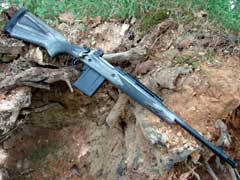
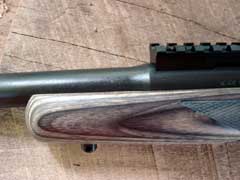
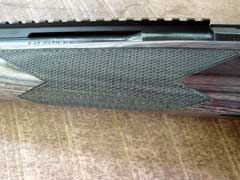
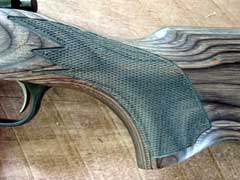
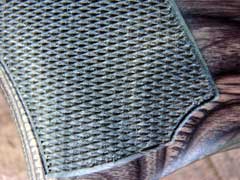
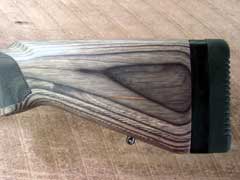
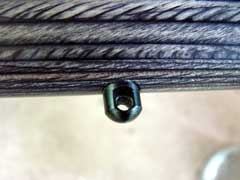
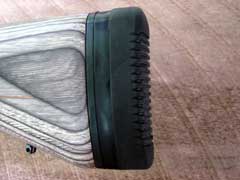
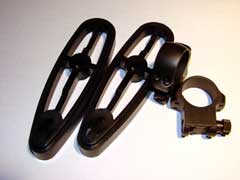
Scout rifle comes with buttpad spacers and scope rings.
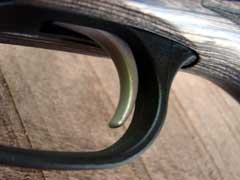
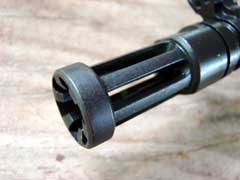
Flash suppressor.
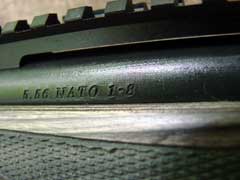
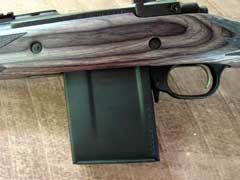
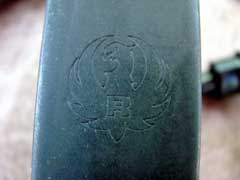
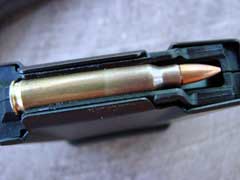
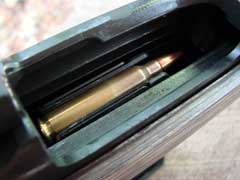
Accurate Mag ten-shot detachable box magazine.
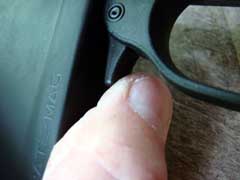
Magazine release.
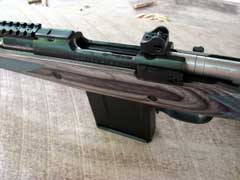
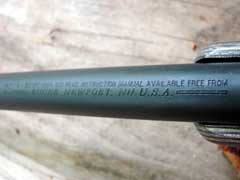
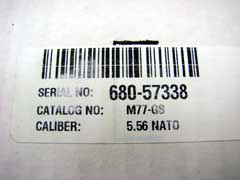
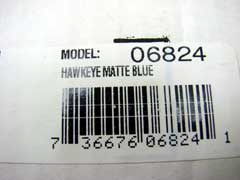
|
|
Ruger introduced their 7.62x51mm
Gunsite Scout Rifle almost four years ago. The then-new take
on the excellent Ruger Hawkeye bolt-action rifle was designed in
cooperation with the staff and management at Gunsite
Academy; the nation's premier gun-fighting school. Gunsite
trains people to fight with firearms; handgun, shotgun, rifle,
and sub-machine gun. The
concept of the Gunsite Scout Rifle started at Gunsite with
the founder, Jeff Cooper, many years ago. Ruger's effort to
build the Scout Rifle has been met with great success, and is
now being introduced in 5.56x45mm, for those who prefer the
lighter cartridge.
The GSR556 will fire both 5.56 NATO and 223
Remington ammunition safely and accurately. The hammer-forged
barrel is rifled one turn in eight inches (1/8) to stabilize
bullets from the light 40 grain class up
through the 77 grain class of bullets. The barrel
measures sixteen and one-tenth inches in length, and the muzzle
is threaded 1/2x28 TPI to accommodate standard muzzle
accessories such as flash suppressors, sound suppressors, and
muzzle brakes. The rifle is fitted with Ruger's effective
birdcage flash suppressor.
The GSR556 uses Accurate Mag pattern
magazines, and is supplied with one steel ten-shot magazine. The
rifle is finished in a matte blue, and the bolt is natural matte
stainless. The receiver is machined to accept the included Ruger
pattern scope rings, which are also a matte blue and built to
accommodate a one-inch scope tube. 30mm rings are also available
to fit the receiver, if desired. Ahead of the receiver is a
section of 1913 Picatinny
rail, to accommodate an optical sight or an extended eye relief
Scout scope.
The stock is made of a gray laminated wood,
with a comfortable butt pad and removable spacers, to allow the
rifle to be fitted easily to a variety of shooters and also to
allow for the wearing of heavy clothing, or a bullet-resistant
vest. The stock is fitted with sling swivel studs fore and aft,
to easily attach a sling or bipod. The pistol grip and forearm
areas are well-covered with useful cut checkering, providing for
a positive grasp in any weather conditions. Besides the utility
of the checkering, it just looks good to me.
The GSR556 weighs in one my scale at seven
pounds, fifteen ounces with an empty steel ten-shot magazine.
The rifle balances very well, and feels about a full pound
lighter in my hands. The overall length varies from thirty-seven
to thirty-eight and one-half inches, depending upon the buttpad
spacers used. The length of pull also varies from twelve and
three-quarters to fourteen and one-quarter inches, again
depending upon the buttpad spacers used.
The GSR556 comes with sights just like those
on the 7.62 version. The rear is an adjustable protected
aperture, and the front is a protected blade. The rear attaches
to the rear ring base machined into the receiver, and the front
is attached to the barrel, just aft of the flash suppressor. I
prefer to mount a scope atop the receiver, but for those who
prefer an extended eye relief scope mounted farther out, the
Picatinny rail will accommodate that type of sight perfectly.
For
accuracy testing, I mounted a Leupold VX-6 1 to 6 power scope
using Leupold 30mm Ruger rings. Usually, I mount my 8.5 to 25
power scope for accuracy testing, but the 1 to 6 power VX-6 is
ideal for such a rifle as this Gunsite Scout, as it works
perfectly at close range with both eyes open, but the six-power
magnification allows the rifle to perform well out to several
hundred yards. Velocity testing was done with the chronograph
set out twelve feet from the muzzle at an elevation of 541 feet
above sea level.. Temperatures hovered around the eighty-eight
degree Fahrenheit mark during all velocity testing, with
humidity in the ninety-two percent range. Velocity readings are
the average of several shots fired, and the results are listed
in the chart below. Velocity readings are listed in
feet-per-second (fps). Bullet weights are listed in grains. FMJ
is a full metal jacket bullet. HP is hollowpoint. V-Max is a
polymer-tipped varmint bullet. TSX is a Barnes Triple Shock
homogenous copper hollowpoint bullet. The handload listed uses
the TSX bullet with 24.5 grains of Ramshot TAC powder, a
Remington small rifle primer, and Winchester commercial .223
Remington cases.
| Ammunition |
Bullet Weight |
Velocity |
| Stryker V-Max |
55 |
2778 |
| Lake City M855 |
62 |
3042 |
| Hand Load TSX |
62 |
2833 |
| Winchester USA FMJ |
62 |
2798 |
| Buffalo Bore HP |
69 |
2876 |
| Buffalo Bore HP |
77 |
2703 |
| Black Hills HP |
69 |
2612 |
| Wolf
Gold HP |
75 |
2495 |
Functioning was, as expected, very smooth and
reliable. The cartridges fed smoothly from the ten-round
Accurate Mag box magazine, and ejection was positive. There was
no sticky extraction experienced with any of the loads tested.
In addition to the ammo listed above, I also fired a lot of IMI
military surplus stuff, as well as some PMC for function
testing.
Accuracy testing really surprised me. As
noted above, I usually use a much higher-powered scope for
accuracy testing, so I was expecting nothing better than
minute-of-angle accuracy from this rifle/scope combination, not
because the accuracy potential was not there, but because it is
harder for me to fire small groups without using my high-powered
target scope, and minute-of-angle is very good accuracy. After
getting the rifle on paper at twenty-five, then fifty yards, I
settled into shooting at one hundred. My usual targets were not
useful to me at one hundred yards, as I could not clearly see
the aiming point with the six-power scope, so I walked out and
placed two-inch orange dots over the aiming points on the paper
target. Settling back in at the bench, I fired three shots on
target. Looking through the spotting scope revealed a nice
three-shot group in the one-inch range, so I was satisfied that
this rifle was going to be accurate, but what happened after
that was very unexpected. The next group fired was with Cor-Bon
69 grain match ammo. The three shots fired into a ragged hole. I
called it good luck, and fired another, which did the same,
followed by another just like it. Setting the Cor-Bon ammo
aside, I reached for some Black Hills 69 grain ammo. The results
were not hardly as good as the Cor-Bon, but still well under the
magical one-inch mark, and I was again very happy, especially
considering the relatively low magnification, my eyesight, and
me pulling the trigger, which was by the way, very crisp and
predictable, releasing with slightly over four pounds
resistance. I next tried the Lake City green tip military ammo,
and while it would serve for social work, it was not
particularly accurate in this rifle. Winchester USA 62 grain
ammo shot very well, under one minute. Trying Buffalo Bore 77
grain ammo, I was concerned that the one-in-eight rifling twist
might not stabilize the bullet well, but it too shot well under
one-minute at one hundred yards. Going back to a 69 grain bullet
again, I reached for my favorite factory load, the Buffalo Bore
Sniper ammo that uses the excellent Sierra Match King bullet,
and was rewarded with half-minute and better groups at one
hundred yards. Every time.
I immediately sent an email to a friend at
Ruger, telling him that he was going to ruin what little
reputation I have left, because no one was going to believe me
when I reported the accuracy of this rifle. I remember a time
when Ruger rifles were not known for fine accuracy. They have
always been very strong bolt guns, plenty accurate for hunting,
but not particularly match-grade rifles. Ruger has invested
heavily in producing their own hammer-forged barrels, and it is
apparently paying off. This particular rifle prefers 69 grain
ammo over all others, and fired remarkably well with every 69
grain load tested.
The Ruger Gunsite Scout is an accurate,
reliable, and very versatile bolt action rifle; one which brings
the concept of the Scout rifle closer to perfection. For those
who desire a Scout rifle, but do not need the power of the 308,
the GSR556 is an excellent choice. Like all Ruger firearms, the
GSR556 is made in the USA.
As I write this review, the GSR556 is being
shipped to distributors, so they can be found in your local
gunshop, or your dealer can get one for you shortly. MSRP as of
the date of this review is $1039 US.
Check out the Gunsite Scout rifle online at www.ruger.com.
For magazines and accessories, go to www.shopruger.com.
For
the location of a Ruger dealer near you, click on the DEALER
FINDER at www.lipseys.com.
To order the Gunsite Scout rifle online,
click on the GUN GENIE at www.galleryofguns.com.
To look at the extensive line of quality
Leupold optics, go to www.leupold.com.
To order quality 5.56x45 and 223 ammunition,
go to www.buffalobore.com,
www.midsouthshooterssupply.com,
www.doubletapammo.com,
and www.luckygunner.com.
For
more information on some of the best world-class firearms
training available, go to www.gunsite.com.
Jeff Quinn
NOTE: All load data posted on this
web site are for educational purposes only. Neither the author nor
GunBlast.com assume any responsibility for the use or misuse of this data.
The data indicated were arrived at using specialized equipment under
conditions not necessarily comparable to those encountered by the
potential user of this data. Always use data from respected loading
manuals and begin working up loads at least 10% below the loads indicated
in the source manual.
  
Got something to say about this article?
Want to agree (or disagree) with it? Click the following link to
go to the GUNBlast Feedback Page.
|
|
Click pictures for a larger version.
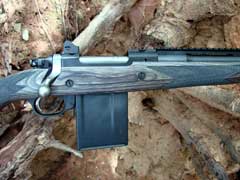
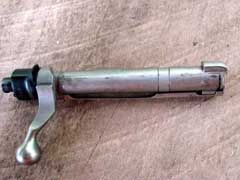
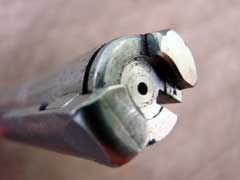
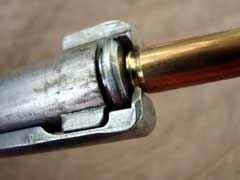
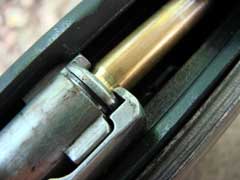
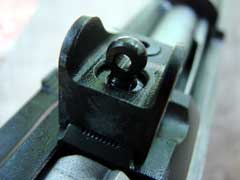
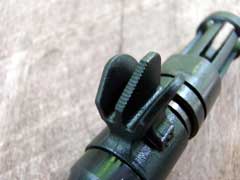
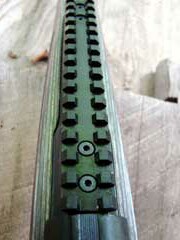
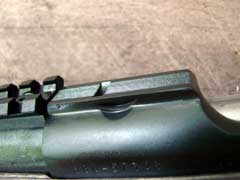
Receiver is machined for included Ruger scope rings.
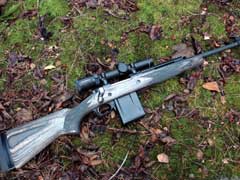
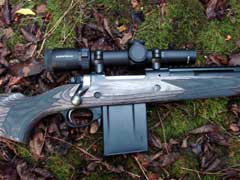
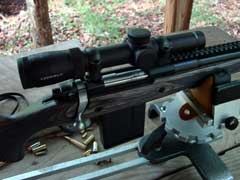
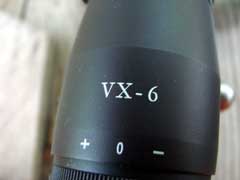
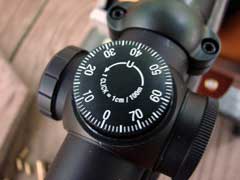
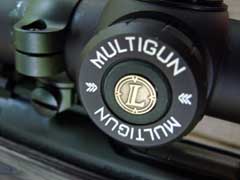
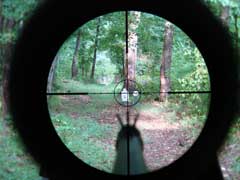
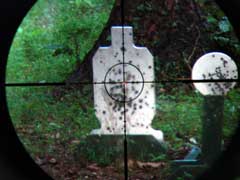
Leupold VX-6 scope is ideally suited for use on the
Ruger Gunsite Scout Rifle.
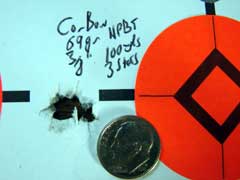
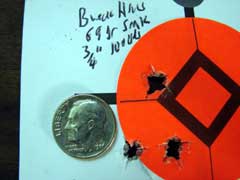
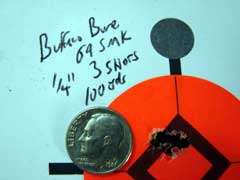
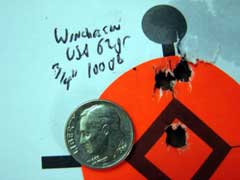
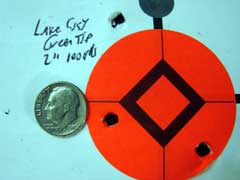
The best and worst groups fired with the GSR-556 /
Leupold VX-6 combo.
|
![]()